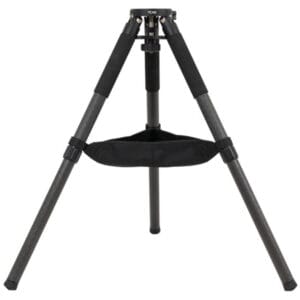Tripods: The foundation of your observation setup
A sturdy and reliable tripod is the cornerstone of any telescope or binocular setup. Without a stable base, every viewing or photography session gets bogged down in frustration due to vibration and sagging. In this comprehensive guide, you'll cover:
Why a quality tripod is indispensable
The main tripod types and material choices
Features to look out for when purchasing
Installation and maintenance tips for years of precision
1. Why invest in a good tripod?
Vibration Reduction
Even the slightest movement limits your sharpness and comfort. A solid tripod absorbs vibrations faster than lightweight models.Precise alignment
A level and robust couplers keep your optics at the exact height and orientation, essential for precise polar alignment.Carrying capacity and portability
The tripod should not only carry your optics and any accessories, but also match your mobile or fixed setups.
2. Materials and types
| Tripod type | Material | Advantages | Cons |
|---|---|---|---|
| Aluminum | Aluminum alloy | Robust, affordable, corrosion resistant | Relatively heavy |
| Carbon fiber | Carbon fiber | Very light, high rigidity, dampens vibrations well | More expensive |
| Steel tripod | Stainless Steel | Maximum stable and heavy | Very heavy, less mobile |
| Compact field tripod | Mix of plastic | Ultra-compact, lightweight, quick to set up | Limited carrying capacity |
3. Important features when choosing
Carrying capacity
Choose a tripod that can support at least 1.5× the total weight of your telescope including accessories.Maximum and minimum height
- Working height: standing work and pole alignment.
- Layer position: for low to the ground objects or observing from the sitting position.Pot closures and locking
- Rotary fasteners versus clamp fasteners:Clamp closures are quick to operate but can wear out.
Rotary latches are more robust, but slightly slower to set.
Center panel and accessory tray
A spacious platform with level and a hook to hang ballast increases stability.Weight and ease of carrying
Consider carrying straps or integrated handles, especially with heavy aluminum or steel tripods.
4. Installation and usage tips
Leveling up
Start with a stable, level surface. Use the built-in level to spread legs evenly.Improve weight balance
Hang a counterweight (bag of sand, metal weight) on the center hook to increase stability in windy conditions.Spread legs correctly
After each movement, check that the legs support evenly and do not sag on soft ground.Inserting accessory plate correctly
The platform must be mounted flat and centrally under the mount; placing it too high or too low affects the clutch force.
5. Maintenance and longevity
Regular cleaning
Remove dust and grains of sand with a soft brush or compressed air to prevent wear on fasteners.Checking closures
Re-tighten clamp fasteners and twist fasteners after each season to minimize slack.Protection against moisture
Store the tripod dry or use a cover; moisture can cause internal rust on steel components.Lubrication of moving parts
Occasionally apply a drizzle of silicone spray to pot hinges and pivots without excess grease attracting dust.
Frequently Asked Questions about Tripods
Which tripod is suitable for a heavy Schmidt-Cassegrain?
Choose a steel or heavy aluminum tripod with a load capacity of at least 15 kg.Should I fold out legs at each corner?
For maximum stability, spread the legs evenly to the recommended angle, usually 60-70°.Which is better: clamp or twist closures?
Rotary fasteners last longer and stay tight, clamp fasteners are quicker to set but can loosen.How do I equalize the leg lengths?
Use the level and mark the legs to equal length or choose a tripod with built-in height stops.Can I use a tripod on uneven terrain?
Yes, adjust each leg individually and use the level to compensate for slopes.How do I hang weight on the tripod?
Attach a sandbag or counterweight to the hook under the accessory platform to reduce vibration.Are carbon fiber tripods really anti-vibration?
Yes, carbon fiber absorbs vibrations better than metal, but is more expensive to buy.How much does an average field tripod weigh?
Between 1.5 and 3 kg, depending on material and size.Should I clean the legs after each use?
Especially for outdoor use; remove sand and mud to prevent wear on clamp fasteners.How do I prevent corrosion on aluminum tripods?
Make the tripod dry and store it indoors; aluminum oxidizes slowly but does not rust like steel.What is the ideal working height for pole alignment?
Around eye level (1.6-1.8 m) so you can comfortably view through the polarizer.Can I use sand or gravel in the legs as ballast?
Usually not: legs are not designed for padding. Use center hook for extra weight.What is a centering plate?
A flat platform with level and screw holes for frames, for quick and precise mounting.How do I maintain plastic parts?
Clean with a damp cloth and mild soap solution, avoid harsh chemicals.Are cheap lightweight tripods usable?
For light scopes and binoculars yes, but not for astrophotography with heavy frames.How do I test the stability of a tripod?
Mount your optics, aim at a horizontal object and gently tap the tube; watch how quickly vibrations subside.Are integrated spirit levels accurate enough?
Yes, most built-in vials provide sufficient accuracy for polar alignment.What is the difference between a middle and side hook?
A center hook hangs directly under the platform; a side hook is more flexible for heavier weights.How do I store a tripod after long sessions outside?
Wipe it clean, let it dry in a ventilated area and store it in a cover.Can I update my tripod with carbon fiber front legs?
Some brands offer separate carbon fiber legs as an upgrade; check compatibility with your turntable.


